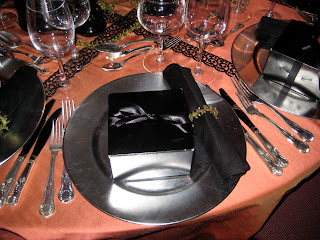I got to see two sides of the design coin this week. Mario Buatta, the Prince of Chintz, was honored this week as part of a gala fund-raiser benefiting the New York School of Interior Design, my alma mater. The evening began with cocktails at the Avenue Antiques and Art Show at the Park Avenue Armory. Nearly two hours later, invited guests entered the Beaux Arts-style Metropolitan Club and found its gilded ballroom made intimate by candlelight, barely restrained floral arrangements, and a celebratory and ebullient mood. NYSID alumni and colleagues mingled, exchanged stories and met with old friends before enjoying a simple yet delicious dinner, followed by tributes in verse and song to Mr. Buatta, long celebrated for his penchant for exuberant florals and color, matched with a finely tuned eye for antiques and scale. The 75-year-old designer glowed and laughed appreciatively, praising his colleagues for the ballroom decorations and accepting the tribute with grace.
NYSID's table and place setting; color and elegance abound. |
The next night I found myself listening intently in a small auditorium at the Museum of Arts and Design as architects Michael Graves, Granger Moorhead and Gisue Hariri, as well as industrial designer Jeffrey Bernett, contemplated the state of American furniture design. The international perception is that there is no American furniture outside of office systems. To a great extent, the world is right. Much to the chagrin of the panel and those in attendance, innovation has given way to mass industrialization, where profit is king and craftsmanship holds little value. There's hope yet: Small-scale workrooms and manufacturers, working with forward-thinking designers, are poised to take furniture and product design back to the future. Technology aids the craftsman -- and woman! -- and new materials spur new approaches to old conundrums.
The Ring Cuff by Gisue Hariri for Swarovski, a tea kettle for Target by Michael Graves, contract seating for Coalesse by Jeffrey Bernett, and Moorhead & Moorhead's Felt Stool |
The lines between design disciplines have blurred as well. Hariri & Hariri's architectural/interior design commissions continue to garner praise; Gisue Hariri wore a stunningly severe crystal necklace from the new jewelry line she and her sister and design partner, Mojgan, created from Swarovski (the company has started several small, studio-like entities that work closely with designers to launch hand-creafted products, including decorative lighting and jewelry). Both Mr. Bernett (through his Studio B) and Mr. Moorhead, with his brother Robert, have new products in the pipeline. ranging from car seats to modular screens, and each has partnered with companies large and small to release their work. Mr. Graves and Target remain partners—though product releases come less frequently—and his architectural practice continues apace.
All the panelist expressed cautious optimism for the present and future of American furniture design—and American innovation in general. Watching the young, diverse audience nod in agreement and gather for impromptu discussions as the panelists adjourned, I felt the same optimism.
Heads, design wins. Tails, we all win.









No comments:
Post a Comment